Black Belt at Home Blog
Here I would like to answer some common questions I receive about the style of Ultimate Bo and about bōjutsu in general.
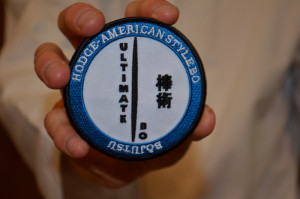 Is Ultimate Bo a training course or a martial arts style?
Is Ultimate Bo a training course or a martial arts style?
Ultimate Bo is a recognized martial arts style; it can also be referred to as Hodge-American Style Bōjutsu. We tend to use the name Ultimate Bo frequently, as it is less of a mouthful, and easily describes the style which we learn and train. The style is derived from Okinawan weaponry, specifically the style known as bōjutsu, which is the art of the staff in Japanese. Currently, the Ultimate Bo style is broken down into two sections: Freestyle Bo and Sparring Bo. Freestyle bo refers to our forms (kata) and technique (kihon) practice. Rather than being pure bōjutsu katas, our style also integrates a small number of American freestyle movements, which may appear somewhat flashy or stylized. These elements do not take away from the total goal and usability of kata training, which was originally designed as a solo combat training drill, in pre-arranged sequences. By adding a few modernistic elements, our katas have a unique flavor and style, which create a high energy flow and aesthetic beauty, without degrading the real combat sequence arrangements within the katas.
It is not unheard of for traditional Okinawan and mainland Japan karate styles to include artistic elements within their katas. Some movements are power building techniques, which stem from Zen Buddhism mediation and breathing exercises, which are initiated before an explosion of power or combat engagement. It is also worth noting that our katas include a few elements borrowed from Chinese staff styles. You will notice a few of these techniques which are very different in nature in our brown and red chevron katas.
The other section of Ultimate Bo is Sparring Bo. In the current edition of the Ultimate Bo course, we do not go into great detail and specificity in the realm of combat. The focus of our sparring techniques revolve around bo vs. bo confrontations. I am not condoning that you should train and work on sparring with a staff every day, in case a mugger gets the drop on you with a 6 ft. rattan staff. Our sparring practice and point competition matches simply allow us to develop a better working understanding of footwork, angles, blocking, counter-attacks, and strike points while engaging with an opponent/partner. Ultimate Bo sparring is fun, a great workout, and develops good reactions. In the next iteration of the Ultimate Bo program, which is set to release later this year, we will expand the sparring bo section considerably, to delve deeper into how the staff can be useful in defensive circumstances, as well as taking into account ippon kumite of traditional bōjutsu.
All in all, Ultimate Bo is meant to live up to its namesake – the “ultimate” in learning how to use the “bo.” Rather than just learning pure Japanese staff, Chinese staff, or even modernistic American style competition Bo – we take all into account. I am even learning more about European pole arms, fencing concepts, the jo, kali, and some sword principles in my study and preparation for the next iteration of Ultimate Bo.
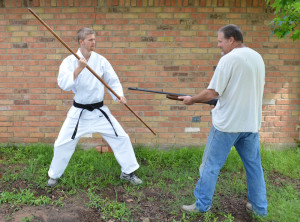 Does Ultimate Bo teach you how to defend yourself and fight with a staff in the real world?
Does Ultimate Bo teach you how to defend yourself and fight with a staff in the real world?
Yes and no. There are certain basic concepts which, if learned and trained enough, can serve you well in an unexpected scenario. But, let’s get real. We live in the 21st century; this is not 15th century feudal Japan. Many things have changed. The focal point of our bo training is not combat, fighting, defense, killing, and war. That is almost like training to be an online journalist with a quill and ink. I realize that being a master fighter with a staff would not serve you greatly in this day and age, but there are obviously benefits. Teachings which benefit you whether you are alive now, or in the days of Miyamoto Musashi. When you practice combat and sparring with a staff, you develop an understanding of a weapon art. The reactions, stances, footwork, angles of attack, blocks, and principles carry over to sword practice, nunchakus, and other weapons. Being able to pick up a crow bar, lead pipe or whatever, and striking vital points with proficiency and without hesitation could matter. Grabbing a broom stick in a knick of time to parry a projectile or whatever could matter. Using a walking stick in defense of an animal on a hike through the mountains could matter. So, there are clearly some combat type benefits which can be realized. But again, that is not really our focal point.
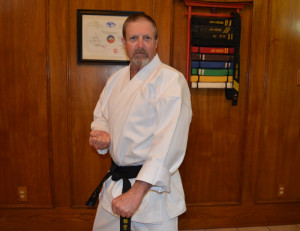 Will learning Ultimate Bo complement my Tae Kwon Do/Karate/Other Art training?
Will learning Ultimate Bo complement my Tae Kwon Do/Karate/Other Art training?
Yes it will. I started training with the nunchakus and bo right after earning my 1st degree black belt in song moo kwan. We tend to use similar stances and concepts in the bo katas, as with most traditional systems. The bo training will benefit your upper body flexibility, strength, endurance, and mobility. This is a surprising benefit of using the bo, you get a really good cardio workout, and upper body specific strengthening.
Ultimate Bo sparring will allow you to discover new angles of attack, defense, and footwork; which can be translated into empty hand sparring. I think the largest way that is compliments your current style, is through creating a new love and excitement for the martial arts. Sometimes, especially when students reach advanced ranks (around brown belt), or even after finally achieving a 1st degree black belt, a student can get the feeling that they have already learned the bulk of what their school has to offer. In this case, it can be great to start learning something new, which compliments rather than diverges your attention from the traditional martial arts.
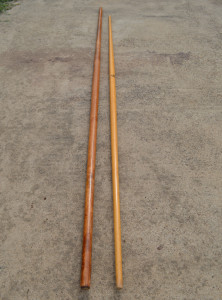 What type of bo should I train with?
What type of bo should I train with?
This depends on why you are training and how experienced you are. Here is my recommendation for Ultimate Bo students:
- Beginner Levels (Yellow – Blue Chevron): It is a good idea to have a lightweight bo for properly learning and mastering the freestyle katas in these first three levels. If you start out with a 3 lb. staff, you can easily hurt yourself, or inhibit proper technique due to fear of hitting yourself too hard. Begin with something like the Ultra Light White Wood Lotus Bo Staff. This is the bo I use in the majority of the Ultimate Bo DVDs. Bamboo or rattan staffs are also good options.
- Advanced Levels (Brown – Black Chevron): Now that you have been training for several months or more than a year, you need to take off the training wheels. Go ahead and get a heavy weight bo. I mean, an actual bo which you would use in bōjutsu kumite and combat. I have been using this 2 lb. ash wood staff for a while now, and really like it. It is hard, well made, and stands up to some beatings. When you begin to practice with a heavier bo (like an ash or oak bo), your techniques will be much slower. Give it some time. You will develop more strength and control. After a month of working with my ash bo, I picked up my white wood lotus, and it seriously felt like a toothpick.
- Sparring/Combat – For actual partner practice and fast speed kumite, the best I have ever used is the Actionflex staff. In traditional bōjutsu practice, a heavy oak bo or other hardwood is used with great control and caution. I favor the padded staff, for the same reason that Kamiizumi Nobutsuna crafted a bamboo practice sword, instead of a wooden sword. He found that his students could practice with more realism and combat speed, without lasting injuries; which wooden swords tended to inflict.
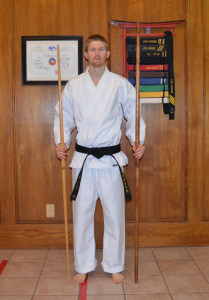 What size bo should I use?
What size bo should I use?
I have answered this question before in my popular post, The Complete Beginner’s Guide to Bo Staff. I would like to expand upon my answer. The size of your bo depends on the purpose of your training. Traditionally the bo has been 6 ft. long. Bo comes from the word rokushakubō, which refers to a staff which is about 6-shaku (1.82 m; 5.96 feet) long. Traditionally a bo has been used for combat as well, but we live in a day and age that has different uses for this quarterstaff.
- Competition/Freestyle Practice – For freestyle and competition style bo, which you often see in XMA and tricking, a slightly shorter bo is used. I also like using a slightly shorter bo when doing our Ultimate Bo katas, especially if speed is somehow important to my demonstration. Most staffs come in ½ foot increments. So, if you are 5’11’’ (71 inches; 180 cm), you would opt for a 5’ 6’’ (66 inches; 168 cm) bo. And so on and so forth.
- Combat/Kumite/Sparring Practice – When practicing sparring bo and combat scenarios, you need a slightly longer bo. The extra reach will be useful in distance thrusts, and you will have more area covered by the staff, which gives you a better defense. You do not run the risk of slamming the staff into the ground or losing control over it, which is one of the main challenges with a longer staff, in freestyle practice.
I do hope that my answers have been helpful. I love practicing with the bo, and am always learning more. I do not claim to be a master or the greatest teacher of the staff, I simply have a love for learning and exploring it; and have dedicated a great deal of time in creating a truly organized way to train, progress, and earn rank through the study of this weapon.
If you are interested in learning this weapon with me, I do urge you to join the Ultimate Bo Home Study Course. This course will teach you the entire style from white to black chevron, and I will be there for you along the way. I answer my students’ questions personally, or on the student forum. I also film a personal feedback video with every rank exam grading that I do, which allows me to give you detailed guidance and feedback; just as if you were coming to train with me locally each week.
I am also working on the next iteration of Ultimate Bo at the moment; it will be out later this year. You can purchase and join the course with full confidence now, to start learning, ranking, and laying a strong foundation. Once the new material comes out, you will have more tools and knowledge available for a more extensive study of our art.
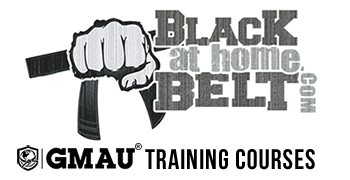
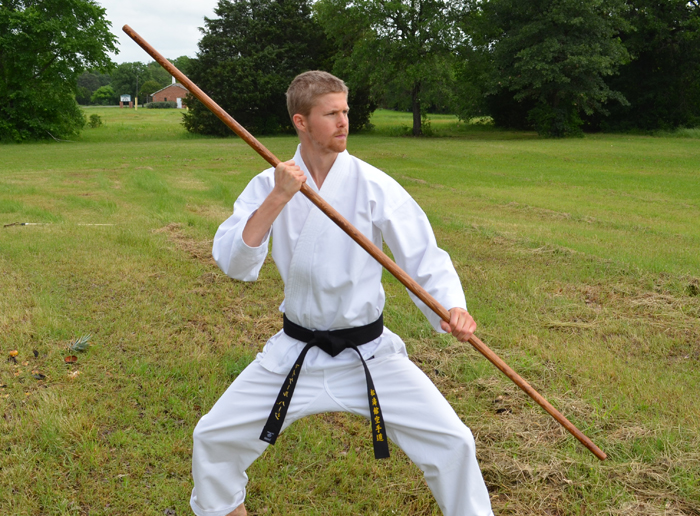
I read somewhere that after completing a belt, you will be sent a package with a certificate and belt, is this possible with the DVD version only? Also is there a place to buy the DVD version by itself aside from other sites that offer it? (Like Amazon) Thank you!
Hi Kayden, Yes, you can earn official rank in the art of Ultimate Bo through our distance training enrollment. If you do buy the DVD version, you would then need to enroll as a Global Martial Arts University member. You could get a Basic Membership or a Full Student Membership. This page explains it better: https://www.blackbeltathome.com/choose-your-student-membership/ And yes, you can get the Ultimate Bo core curriculum 8 DVD set from amazon: https://www.amazon.com/Ultimate-Bo-Beginner-Black-Course/dp/B01MG6EDVD
Hi Michael,
I have an odd question. I’m currently writing a novel, and am looking for someone to review a couple of pages of my text to make sure I have described my characters correctly in how they are handling their weapons in this scene. Is that something I could interest you in? I know many of my readers are very familiar with the bo staff, and I want to make sure the scene is believable and accurate.
Thanks in advance!
Hi Shannon, Yes, I would love to help you with this. Please send us a message on the Contact Us page of this website, addressing your message to Sensei Michael. Thanks!
Hi, I have picked up an interest in the Jo. Is it the same techniques and moves as the Bo? If not do you know where I can learn the Jo online. Thanks in advance.
Honestly, I have not personally trained with a “jo” master. From my personal understanding, the techniques are very similar, but some can blend into kali training due to the length. But, they do lean more toward the side of bojutsu.